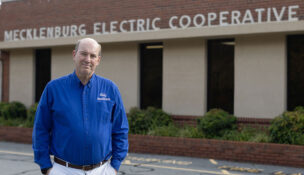Tilting at windmills?
Onshore wind seems stuck in neutral
Virginia Business //March 31, 2013//
In its integrated resource plan, Dominion Virginia Power told state regulators last year that it wants to develop a combined 248 megawatts of electricity from three onshore wind farms in Southwest Virginia. Thus far, those windmills have yet to move from the drawing board.
They include a proposed wind farm in Tazewell County, despite an ordinance passed by county leaders in 2010 that effectively kills the plan. The ordinance prohibits the building of structures taller than 40 feet on mountain ridgelines. The Bluestone River wind generation project in Tazewell originally was planned as a joint venture by Dominion and BP Wind Energy North America. The two companies purchased 2,560 acres of land in Tazewell and planned to install up to 60 turbines on East River Mountain, with each turbine measuring 400 feet in height.
Two other onshore wind sites in Virginia also are being evaluated, although Dominion officials did not disclose the locations or possible timelines. “We still consider all three sites to be under development,” says Kelly Scott, Dominion’s director of fossil fuels and hydro operations.
Elsewhere in Virginia, officials in Carroll County have postponed a decision on a wind farm proposed by EDP Renewables/Horizon Wind Energy. Meanwhile, Woburn, Mass.-based Solaya Renewable Energy has announced plans to erect a wind farm in Rockingham County on a ridge straddling the Virginia/West Virginia line. The company has not specified a date when construction will begin.
During the 2013 General Assembly session, Virginia legislators removed enhanced financial incentives designed to encourage utilities to add renewable projects here. The so-called “adder” has failed to achieve its aims, according to a report last year by the office of the attorney general, Ken Cuccinelli.
The report said that, rather than leading to clean-energy projects in Virginia, the incentives enabled utilities to purchase renewable energy certificates for out-of-state projects and still qualify for enhanced returns on equity. The practice “contributed to increases in customer bills” and let a utility keep profits that exceeded the “fair rate” set by state regulators.

















